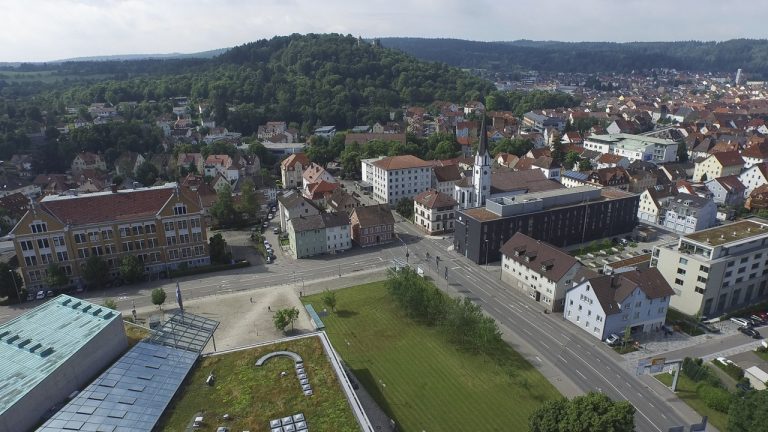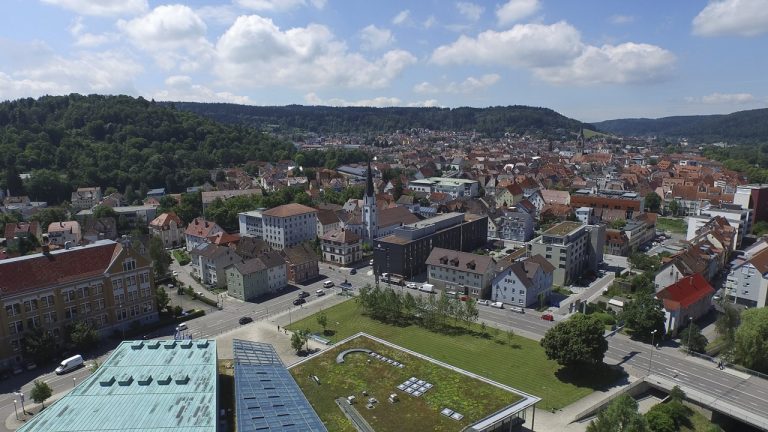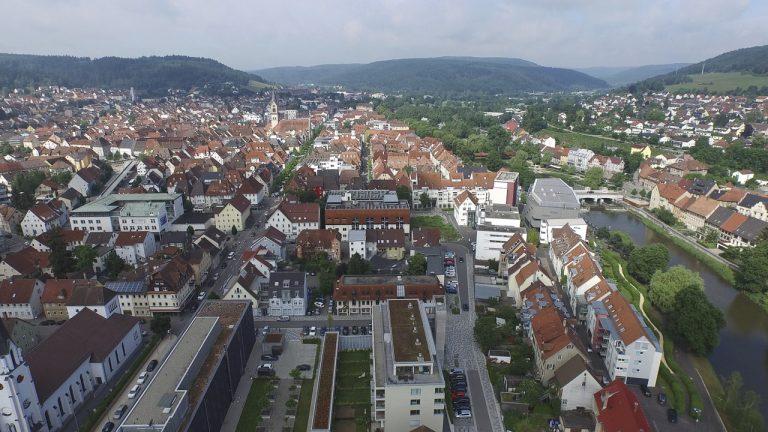World centre of medical technology
The history of Tuttlingen
In 1997 the town of Tuttlingen celebrated its first documentary mention as “tuttiliningas” 1200 years ago with many festivals, cultural events and a large parade.
The town’s landmark is the ruins of the fortress Honburg, built around 1460 and pulled down in 1645 on a Umlaufberg, around which the large district town with its 35,000 inhabitants has completely “built around” in recent years. A short steep climb is rewarded with a wonderful view directly into the city centre and far beyond.
Particularly recognizable is the chessboard-like road construction principle in the inner city, built according to the designs of the agricultural architect Carl Leonhard von Uber after the devastating town fire of 1803.
The market place with the idiosyncratic modern fountain pyramid and the town hall with classicist origins forms the town centre. Around it a pedestrian zone has been created with many shopping and gastronomic facilities. Only a few meters from the market place in the Bahnhofstraße another landmark, the protestant town church built between 1815 and 1817 with a magnificent art nouveau facade and a highly interesting, almost unusual looking interior. In addition to the town hall in the direction of the Danube, the Städtische Galerie, which opened in 1987, offers a good opportunity for a relaxing stay with its changing exhibitions.
A few metres further to the west, the Place de Draguignan (Tuttlingen’s twin town) with its street café offers perhaps the most beautiful place to sit down for a drink or a snack in the summer months. This square is also the centre of the annual “Tuttlingen Wine Route”, a convivial wine festival with culinary specialities, which brings thousands of sociable people together over a long weekend in a humid and cheerful atmosphere. It goes without saying that this festival, together with the big city festival and the “Honberg Summer”, a music and show festival with international stars, is a highlight in Tuttlingen’s art and festival year program.
Once again, only a few more metres to the west of the Place de Draguignan is the magnificent “Fruchtkasten” (fruit box) with its striking green façade, the city’s museum of local history, which is well worth seeing, with an extensive medical technology department that offers an overview from the beginnings to the present day.
Opposite the museum entrance, the “Tuttlinger Haus” was only ceremonially opened in 1997. With its depiction of the way of life in past centuries, it completes the impressive museum offer in Tuttlingen.
The economic life of this city is naturally shaped by the production of surgical instruments and medical technology. In addition to the world-famous market leaders Karl Storz and Aesculap (with the ultra-modern training centre “Aesculapium”), several hundred other small and medium-sized manufacturing and trading companies clearly form the economic backbone of the entire district. This entire historical development is also impressively documented in the Tuttlingen local history museum.
Tuttlingen offers everything to make your stay in Tuttlingen an experience in addition to your business activities – Tuttlingen is fun! During your stay, take advantage of the hospitality of the hotels and guesthouses, the excellent traditional Swabian cuisine (of course, international cuisine is also well represented here) as well as the extensive leisure activities on offer, from tennis to swimming and bowling. One last tip for a stay in summer: rent a rowing boat on the Danube (opposite Hotel Stadt Tuttlingen) to find a completely different view of Tuttlingen in addition to guaranteed complete relaxation – we also offer this – and it is definitely worth it!
The beautiful surroundings of Tuttlingen
In only a few minutes by car from Tuttlingen’s city centre you can reach countless places and places worth seeing in the district and beyond.
Here is a small selection:
Of the three districts of Eßlingen, Möhringen and Nendingen, an excursion to Möhringen (6 km west of the city centre) is particularly worthwhile. A well-preserved townscape with many half-timbered houses, a stately town hall and the art-historically important parish church of St. Andreas make a tour of this state-approved climatic health resort worthwhile. To the Fasnet annually in February/March Möhringen becomes the fool stronghold with many merry meetings.
Further 5 km to the west you should not miss the natural spectacle of the danube infiltration . The largest part of the Danube water seeps away here and reappears 20 km south in the Aachtopf in Aach/Hegau.
To the north of Tuttlingen, you should take a short 2.5 km hike from Klippeneck high above Denkingen (21 km from Tuttlingen) with no difference in altitude to the Dreifaltigkeitsberg (985 m). The path leads constantly along the steep Albtrauf with wonderful viewpoints. Both the starting and end points of this excursion offer a good opportunity for a leisurely break.
Probably the most important and eventful excursion from Tuttlingen goes eastwards into the Danube valley. Via Nendingen and Mühlheim with its medieval town centre high above the Danube you will reach Fridingen, founded around 1300, with its castle and beautifully restored half-timbered houses, after 14 km. This is where the most exciting part of the Danube valley begins with its steeply rising rock faces, partly accessible caves (including Kolbinger Höhle), its castles and the striking vantage points, whereby the Knopfmacherfels only 4 km further from Fridingen (easily accessible from the road in 3 minutes) deserves special mention. From this lookout pulpit you can see the famous Beuron Monastery, a Benedictine archabbey with elements of baroque and rococo. The location of the monastery in the middle of a wide rocky circle could not be more impressive. After another 25 km on a good road in the magnificent Danube valley you reach Sigmaringen with its famous castle.
In south-east direction you reach the Stockach after approx. 25 km the Bodensee on the federal road.
7 km south of Tuttlingen you will reach Tuttlingen’s local mountain, the Witthoh with 860 metres in altitude. With a good view, you can see not only the entire Hegau, but also the magnificent chain of Alps from the Allgäu via the Säntis (2501 m) to the Bernese Oberland.
Take your time for the magnificent surroundings. You can see for yourself – you won’t have to travel great distances to reach these destinations. Almost everywhere you will find cosy places to stop for a snack after a long walk.
Are you in Tuttlingen without a car? No problem! A good local transport network will take you to all of the above destinations in an environmentally friendly way. Especially the trip with the Nature Park Express from Tuttlingen through the Danube Valley to Sigmaringen offers you the opportunity to enjoy these natural beauties unspoiled – and you really can’t get more relaxing than that!


